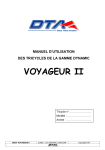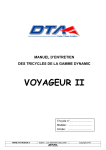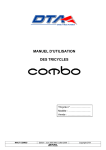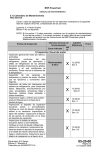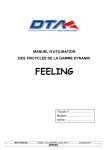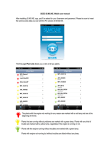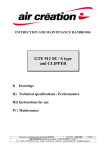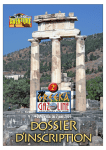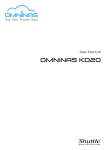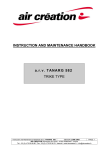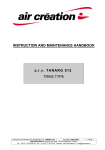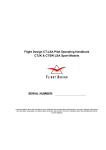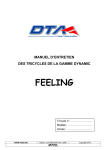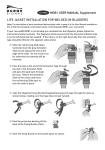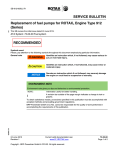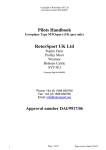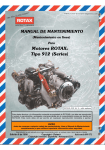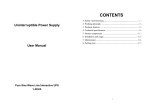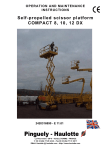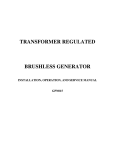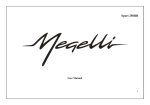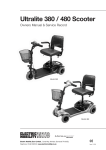Download Voyageur II Instruction Manual
Transcript
INSTRUCTION MANUAL Dynamic VOYAGEUR II AIRFRAME Trike n° : ........................................ Model: ............................................ Year: MAUT – EN VOYAGEUR II Edition : June 2005 .............................................. Copyright DTA – DTA ULM AU SECTION 0 / PREAMBLE Symbols DANGER Identifies an instruction which, if not observed, can cause damage having fatal consequences. ATTENTION Identifies a significant instruction which, if not followed, can cause very serious damage. Reminder, Note : Underlines a useful instruction which must be observed for the proper use and operation of this COMBO airframe. GMP CF Group – Motor/Propeller See Warning The information and the descriptions contained in this Handbook correspond to the current design. That is, the airframe as specified at the time of this publication. It is in no case exhaustive. DTA improves its production constantly, and reserves the right to modify the specification, the drawing, the characteristics, the model and/or the equipment, in the interests of Quality Assurance, without incurring obligation. The specifications are given in the metric system. Note: DTA SARL, a limited liability company, will not be held responsible for errors in translation. The original and reference version of this document is in the French language, and held by DTA SARL Copyright Details: French Version DTA SARL – France 2005 English Version DTA ULM Australia – Australia 2005 No unauthorized copying of this document can be done with out consent, written or verbal, of DTA SARL France. MAUT-EN VOYAGEUR II Edition : June 2005 Section : 0 - 02 Page Index SECTION DESIGNATION PREAMBLE Symbols – Warning PAGE INDEX SECTION 1 GENERAL Reminder of Regulations - Safety Amateur Construction - Description – Addresses PAGE SECTION 3 SECTION 4 SECTION 5 SECTION 6 0 – 02 0 – 03 JUNE 05 1 – 01 1 – 02 CARACTERISTIQUES - PERFORMANCES Dimensions Illustrations with dimensions Accessories - Options Carrying Capacity Calculation Weight Limitations – Flight envelope GMP 2 stroke Rotax 582 DCDI 2V GMP 4 stroke Rotax 912 UL GMP 4 stroke Rotax 912 ULSFR Noise Level – Over flight Height 2 – 01 2 – 02 2 – 03 2 – 04 2 – 05 2 – 06 2 – 07 2 – 08 2 – 09 USE Attaching/detaching the wing on the airframe Illustrations Adjustments – Pre-flight Checks Use of the aircraft Use of the tricycle Starting Rotax 582 motors Starting Rotax 912 and 912S motors Pre-take off check – Take off Cruising - Landing - End of flight 3 – 01 3 – 02 3 – 03 3 – 04 3 – 05 3 – 06 3 – 07 3 – 08 3 – 09 EMERGENCY PROCEDURES Engine failure – Other emergencies Use of a parachute 4 – 01 4 – 02 OTHER USES Loads - Parachutist - Towing 5 – 01 GUARANTEES - TRANSFER Guarantee Card Transfer of Ownership Card ULM delivery report (specimen) Card Quality Control 6 – 01 6 – 02 6 – 03 6 – 04 MAUT – EN VOYAGEUR II Edition : June 2005 UPDATED JUNE 05 SECTION 0 SECTION 2 DATE JUNE 05 JUNE 05 JUNE 05 JUNE 05 JUNE 05 Section : 0 - 03 SECTION 1 / GENERAL This user's manual is supplemented by a Maintenance Handbook and the maintenance handbooks specific to the wing, the engine and the parachute if necessary. These handbooks define the conditions of use, as well as the requirements to maintain the airworthiness of this aircraft. The Pilot-in-Command (PIC): - will use this aircraft (ULM) for sport, leisure and air work only - is responsible for the state of airworthiness of the aircraft (ULM) which he pilots - is holder of a valid current certificate and/or license, necessary to the particular activity - an endorsement for this type of aircraft - will abide by the Regulations and Rules pertaining to Aviation in the country of use and/or registration. - will conform to the recommendations stated in the Maintenance and Instruction manuals relating to this aircraft (ULM), relating to, amongst other things, the flight envelope, the flight and weight limitations and maintenance requirements - will make sure that the aircraft (ULM) is used in conformity with its identification card and that it has not been modified (it is forbidden to modify a whole or a part of the elements composing the aircraft or to add elements by modifying the estimate of weight) - will check that the identification/registration card is valid and that the identification markings (a minimal height of 50 cm for France), attached to the under-surface of the aerofoil, are easily readable - will observe the elementary rules of flight safety: a thorough PRE-FLIGHT, PRE-TAKEOFF, PRELANDING and PRE-MANOEVER procedures and fly always with reference to the ‘CONE OF FLIGHT SAFETY’, etc…. This document was drawn up in accordance with the current French Regulations, relating to ultra/microlight (ULM) aircraft. Note: Be aware of the Regulations regarding the maintenance of Microlight (ULM) aircraft and the responsibilities of the Pilot in Command and/or owner of a Microlight (ULM) in the country of registration of the Aircraft. DTA SARL will NOT be held responsible. Be aware that the ULM in France are not, subject to certification. Safety Our aircraft (ULM) are delivered as standard without flight instrumentation. We recommend the installation of an altimeter (in feet), an Air Speed Indicator (in the unit of speed measurement of the country of registration), and a compass. Check with the National Regulatory bodies of the country of use to ascertain the minimum required instrumentation. The information given by the instrumentation can be erroneous. The engine can break down. The movement of air by nature is unpredictable. It can be sudden and violent and thus compromise the safety of the aircraft. To pilot an aircraft (ULM) is an activity which can involve dangers and which requires adequate training. MAUT – EN VOYAGEUR II Edition : June 2005 Section : 1 – 01 Case of Amateur Construction The DTA Voyageur II airframe, with its various motor combinations can be equipped with other weight-shift delta wings. When manufactured by other than DTA; provided the characteristics of the wing, weight limitations, hang bracket characteristics, control bar clearance, keel length, motor combination, etc, are compatible with the DTA airframe under consideration. The position of the propeller axis requires wings with "short keels". It is necessary to maintain a minimum distance of 10 cm between the wing (structure/wing) and the propeller blade tip, this clearance MUST be in the full range if motion of the Control Bar. The characteristics of the Voyageur II airframe, with its various motor combinations, accessories and options, must also be compatible with limitations imposed by the manufacturer of the wing. France: in accordance with the Law of 23 September 98 amended by the decree of May 15, 2001, the assembler of a wing and a tricycle of different manufacturing origins is considered to be the manufacturer of the aircraft (ULM), and consequently must ask for a "Carte d’identification provisoire d’ULM" in order to carry out the flight tests, and to lodge with the Directeur de l’Aviation Civile a “Dossier Technique de Construction Amateur". Australia: This aircraft has been accepted as a complete aircraft. Alteration or modification is NOT allowed. AU CAR 95.32 Worldwide: (please check with you Regulatory Authority) The amateur builder will assume ALL responsibilities related to any modifications and the flight testing. Caution: badly attached powerful motors, the presence of badly designed or poorly positioned fairing can cause interactions between the wing and the airframe which can abruptly and negatively impact the behavior of the aircraft and make it uncontrolable. Description Fuselage: weight-shift (pendulum) two-seat tandem Aerofoil: flexible delta wing, models DYNAMIC 15/430, DYNAMIC 16/430, DYNAMIC 450 Motor: 2 stroke water cooled: 4 stroke water + oil cooled: 4 stroke water + oil cooled: ROTAX 582 D.C.D.I. - 2V ROTAX 912 UL ROTAX 912 ULSFR Manufacturers Address Fuselage and Wing: D.T.A SARL Aérodrome F-26200 MONTELIMAR Tél. : 04 75 01 20 83 Fax 04 75 51 36 72 [email protected] Motors: ROTAX A- 4623 GUNSKIRCHEN – AUSTRIA, imported by MAD 11 bd Albert 1° 98000 MONACO Tél. : 00 377 93 30 17 40 Fax 00 377 93 30 17 60 MAUT – EN VOYAGEUR II Edition : June 2005 Section : 1 - 02 SECTION 2 / TECHNICAL CARACTERISTICS - PERFORMANCE Dimensions Overall lenght with wing Wingspan Height with wing DYNAMIC 15/430 3,00 9,80 3,60 196 kg DYNAMIC16/430 3,00 10,30 3,60 196 kg DYNAMIC 450 3,00 10,20 3,60 201 kg DYNAMIC 15/430 3,00 9,80 3,60 221 kg DYNAMIC 450 3,00 10,20 3,60 226 kg DYNAMIC 15/430 3,00 9,80 3,60 224 kg DYNAMIC 450 3,00 10,20 3,60 229 kg Model VOYAGEUR II DYNAMIC range Lengt of airframe bare Lenght of airframe faired Width of airframe bare 2,58 3,02 1,95 Rotax 582C Rotax 912UL 2,65 Rotax 912ULSFR 2,65 2,95 2,95 1,95 1,95 Width with Empty fairing weight (std) 2,00 2,00 2,00 Airframe with aerodynamic profiles (powder coated white) Cantileve vertical mast (with wing incidence angle limiter) and no front strut Large all-moving foot pedals Front wheel with suspension, brake and polyester mudguard Aerodynamically profiled rear landing gear struts 2 positions adjustable front fork For your security Airframeand rigid passenger support frame constructed with stainless steel - TIG welded Engine mount and rear axles - 4130 aircraft grade steel Front and rear bucket ergonomic seats, carbon composite 6 plys 600x6'' aviation tyres Powerful brakes on all 3 wheels Parking brake on all 3 wheels Foot and hand throttles (hand throttle protected by pilot seat) Oleopneumatic rear landing gear suspension Key ignition For your comfort Forward-tilting seats for better passenger access and refueling Ergonomic seats with removable padded seat covers, blue (or black colours) Easy raising of the wing due to specially placed pivot point and mast geometry Padded passenger headrest blue (or black) Rear passenger footrest Documen,t pouch in rear passenger seat Delivery with Rotax toolkit, spare fuses, butterfly nuts, hyper syphon fueling Large capacity Voyageur side bags bue (or black), 20 litres, detachable with carry handles GMP Enngine mount 4130 aircrtaft grade steel TIG welved 75 litres injection moulded fuel tank with fuel gauge Rubber mounted polyester instrument console (for integrate radio) Ignition swithes / engine kill-swith / starter by key Fuel gauge Instrument console cover blue (or black) GMP, accessories and instrumentation: CF section 2 - 06 à 2 - 08 MAUT – EN VOYAGEUR II Edition : June 2005 Section : 2 - 01 Illustrations and dimensions 1.79 2.5 0 1.40 1.72 / 1.82 MAUT-EN VOYAGEUR II Edition : June 2005 Section : 2 - 02 Accessories Definition Comments Spats for rear wheels 6' ' Front fairing Requires wheel spats Skirt with integrated satchels requires front fairing Front bag requires front fairing Simple skirt requires front fairing Parachute GRS 3/450 out of container with attachments for 582 Parachute GRS 3/450 out of container with attachments for 912/912S Dual nose-wheel steering controls Dual foot throttle controls Rear Seat Dual ignition controls Towing Kit – Hang glider or Banner specify 582 or 912/912S Altimeter – 3 hand, barometric subscale Ø80mm Analogue Air Speed indicator Ø 57mm or Ø 80mm Variometer – analogue Ø 57mm Pedestal Compass with mount on front bar Compass – panel mount Ø 80mm Radio VHF Icom ICA3 Case for radio VHF ICOM ICA3 Antenna whip granted Intercom- Lynx external power or Alphatec radio Filter type Lynx with 2 outlets (type RCA) requires an auxiliary battery requires an auxiliary battery Battery 12V 7A for radio or strobe Becker Radio require a battery bracket Becker Transponder – ‘Mode C’ type Becker radio + Becker transponder Strobe (flash-light) Oil injection requires console XXL Voyageur requires an auxiliary battery Rotax 582 Cylinder Head Temperature (CHT) in degrees Celsius Exhaust Gas Temperature (EGT) in degrees Celsius Rotax 582 Rotax 582 Intake Temperature Carburettor heat – intake pre-heat by exhaust Rotax 912/912S Rotax 912 and 912S Carburettor heat - intake pre-heat by liquid cooling circuit Rotax 912 and 912S Thermostat on the liquid coolant circuit Rotax 912 and 912S Torque limiter Landing lights - Hella Xenon Parking Cover Control bar sleeves Fuselage - Yellow - Colour RAL 1028 Rotax 912 according to motor and fairing Options Definition Comment Electric fuel priming pump (replaces the manual pump) Electric starter (E type gearbox, replaces C type) Rotax 582 with starter Rotax 582 Propeller – Arplast three blade (replaces DUC F300 – three blade) Rotax 582, 912, 912S Propeller - Arplast four blade (replaces DUC F300 - three blade) Rotax Flydat (replaces the standard analog instrumentation) Rotax 582 - reduction i=3,47 becomes i=4 Rotax 912 et 912S Console XXL (replaces STD console) Inertia reel three-point seatbelt (mount plate replaces) X-Large Satchels ‘Cape to Cape III’ (replaces Voyageur STD satchels) MAUT – EN VOYAGEUR II Edition : June 2005 passenger and/or pilot Section : 2 - 03 Carrying Capacity Calculation guide with the following options and accessories Motor / gearbox: Empty weight – Voyageur II: Wing: DYNAMIC 15/430 DYNAMIC 16/430 DYNAMIC 450 (472,5) Options: Carb Heat – exhaust type (912/S) Coolant circuit thermostat (912/S) Oil circuit thermostat (912/S) Torque limiter 912 Intake temperature EGT or CHT (2 Stroke) Starter 2-stroke + battery 16A Oil injection Option Arplast – three blade propeller Option Arplast – four blade propeller Option front strut (for cantilever mast) Option 1 – inertial reel seatbelt Side satchels XXL Wheel Spats – type Feeling 6'' R + L Front fairing including mounts Simple skirt Skirt with integrated satchels Front bag Altimeter 3 hand Ø 80mm Airspeed indicator Ø 57mm ou Ø 80mm Compass panel mount or pedestal Vario or Altimeter Ø 57 Battery 12V8AH for radio or strobe Intercom Lynx external mount 2 outlets RCA : Filter - Fusible Antenna whip Option Console XXL Option Radio Becker Dual Command nose gear wheel / gas foot / ignition Training bars (for wing) Parachute GRS 3 / 450 with bracket Towing Kit Hang glider or Banner Landing light – Hella Xenon Wing Cover Empty weight: Maximum Takeoff Weight: Carrying Capacity: MAUT – EN VOYAGEUR II Kg 582/C 142 912 167 912S 170 54,00 54,00 59,00 0,90 0,60 1,00 2,00 0,30 0,20 11,00 1,50 0,40 2,00 1,70 0.70 1,20 4,00 4,80 1,80 2,90 0,40 0,60 0,30 0,30 0,30 2,70 0,60 0,30 0,15 0,80 1,00 1,80 2,20 14.8 1,10 0,90 1,80 Edition : June 2005 Included Section : 2 - 04 Empty weight The empty weight indicated is that of a standard machine, complete, in flying condition, without options, flight instrumentation, toolkit, documents or fuel. Shown on the Weight Card given with the machine at the time of the delivery, the empty weight indicated is that of the referred machine, with the accessories and options defined in the Delivery order and/or the final Invoice, without toolkit, documents and fuel. Weight Limits and COG For your safety, in all the configurations, the maximum empty weight will be lower than: DYNAMIC 450: 260 kg DYNAMIC 16/430: 240 kg DYNAMIC 15/430: 240 kg CF: WING MANUEL All loads should be carried as close to the COG of the aircraft as possible, i.e around the back seat, The Maximum Take-Off Weight (MTOW) of each wing should ALWAYS be taken into account. - The side satchels located on both sides of the back seat can carry 2 x 4 kg. - The document pocket located at the rear the seat cover of the pilot seat can carry 2 kg. - The front bag (front fairing configuration) can carry 3 kg. To maintain the fuselage’s in-flight balance, the front seat, in all adjusted positions, should carry a minimum of 50 kg and a maximum of 110 kg. The aircraft should NEVER be flown solo from the rear seat. Load Limits Operational Load Limits for the Voyageur fuselage: • in flight: + 4 g 0 (- 2 g in gusts) at 472.5 kg • on the ground: + 3g at 472.5 kg Operational Load Limits of the Voyageur Aircraft (ULM): CF WING MANUEL (MAUT-DYN - EN) Air Speed at MTOW CF WING MANUEL Flight Envelope Limitations CF WING MANUEL • • Maximum Angle of Bank Maximum Pitch 60° +/- 45° The observance of this flight envelope is imperative. This Aircraft (ULM) is NOT designed for aerobatic flight. Flight manoeuvres which result in negative load factors are completely prohibited. Tow-release operations are authorized only by a progressive increase in pitch, idling engine, in straight and level flight, nose down, at an minimum altitude of 500 meters. Beyond the limits (bank 60°; pitch ± 45°), loss of stability or control, structural failure, or tumbling can occur. MAUT – EN VOYAGEUR II Edition : June 2005 Section : 2 - 05 Power Unit (GMP) Brand - type - cycle Rotax - 582 DCDI 2V - 2 stroke A number of cylinders 2 cyl. - 580,7 cm3 Rotation of propeller (Aircraft (ULM) viewed from behind – PTO) Double electronic ignition Ignition check at 3500 rpm – max difference between circuit 1 and 2: 120 rpm Integrated alternator Number of carburettors or electronic injectors Fuel (adapted according to climatic zone or conditions) 2-stroke oil (injected or mixed) and rotary valve Proportion oil in mixture (advised semi-synthetic) 50:1 fuel/oil mix Separate lubricating system Gear box Oil Radiator coolant Manual priming pump for the fuel system Electric priming pump for the fuel system Maximum power output – maximum revolutions Duration in minutes at maximum power Continuous power – revolutions continuous power Maximum governed speed not to be exceed Idle Fuel Consumption at 75% continuous power Cooling fluid (radiator expansion-bottle recovery system) Vanne thermostat on water circuit Cylinder Head Temperature (CHT) in degree Celsius Liquid Coolant Temperature in degree Celsius Exhaust Gas Temperature (EGT) in degree Celsius Exhaust – Steel (high temperature paint coating) Exhaust – stainless Steel Exhaust Silencer Intake Silencer Pull-start Electric starter Gear-box type B i = 2,58 Gear-box type C i = 3,47 Gear-box type C i = 4 Gear-box with electric starter type E i = 3,47 or 4 Propeller – Duc three-bladed F300 Propeller – Arplast three-bladed or four-bladed Regulator – 3 phases with 2200 MF condenser Ignition switches / engine kill-switch by key Ignition switches / engine kill-switch / starter by key Battery with power switch for the instrumentation Fused electric circuit protection Tachometer Hour meter Water Temperature Gauge Cylinder Head Temperature (CHT) Clockwise STD maximum drop 300 rpm 12V - 155W 2 Bing carburettors min RON 90 or AVGAS 100LL ASTM/CEC STD class API-TC 2,0% O API-GL5, SAE 85W-140 EP Anti-freeze anti-corrosion for AL block STD Option 48 kW at 6500 rpm 6800 rpm 2000 rpm 20 L/h STD STD Max 150° - optimal 110°/130° Max 80° - min 65° Max 650° - optimal 500°/620° STD Option STD STD STD Option Option STD Option Option STD Option STD STD Option Option (radio, strobe, electric starter) STD STD (analogue) STD (analogue) STD (analogue) Option Exhaust Gas Temperature (EGT) Option Manufacturer Data - also see the Rotax Maintenance & Users Handbooks MAUT – EN VOYAGEUR II Edition : June 2005 Section : 2 - 06 Make - type - cycle Rotax - 912 UL - 4 stroke Number of cylinders 4 cyl. - 1211 cm3 Compression ratio Direction of propeller rotation from rear (rotation in reverse direction prohibited) Dual ignition Ignition check at 4000 rpm – maximum difference between 1 and 2: 120 rpm Integrated alternator Number of carburettors Fuel (adapted according to climatic zone) Radiator coolant Engine oil (3L- adapted according to climatic zone) Electric prime pump for the fuel system Maximum power output – maximum revolutions Duration in minutes at maximum power Continuous power – revolutions continuous power Maximum governed speed not to be exceed Mini idle Fuel consumption at 75% continuous power Cooling fluid (radiator expansion-bottle recovery system) Cooling oils (reservoir and radiator) Cylinder Head Temperature in degree Celsius Oil Temperature in degree Celsius Oil Pressure in bar Exhaust Gas Temperature (EGT) in degree Celsius Stainless Exhaust Exhaust Silencer Intake Silencer Electric starter Integrated gearbox i = 2,27 or 2,43 Gearbox Torque limiter Propeller – Duc three-bladed F300 Propeller –Arplast Three-bladed Voltage regulator with condenser 22000 MF Ignition switches / engine kill-switch / starter by key Battery with power switch for the instrumentation Fused electric circuit protection Tachometer Hour meter Cylinder Head Temperature Indicator Oil Pressure Gauge Oil Temperature Gauge Exhaust Gas Temperature (EGT) Charge and Oil Pressure warning lights Intake temperature gauge Digital replacement of Analogue instrumentation Carburettor heat – intake pre-heat by exhaust Carburettor heat - intake pre-heat by liquid cooling circuit Thermostat on water coolant circuit Thermostat on oil circuit 9,0:1 left, counter clockwise STD Maximum drop 300 rpm 12V - 240W 2 Bing carburettors min RON 90 or AVGAS 100 LL antigel anti-corrosion for Al block oil motor bike 4 stroke semi synth. API SG or SG STD 59,6 kW at 5800 rpm 5 min at 5800 rpm 58 kW at 5500 rpm 5800 rpm 1400 rpm 16,2 L/h STD STD max 150° - optimal 80°/100° min 50° - max 140° - optimal 90/110° min 1,5 bar - max 7 bar - optimal 2 - 5 bar Max 650° - optimal 500°/620° STD STD STD i =2,27 Option STD Option STD STD STD STD STD (analogue) STD (analogue) STD (analogue) STD (analogue) STD (analogue) Option STD Option Option Option Option Option Option Manufacturer Data - also see the Rotax Maintenance Handbook & Users Handbook MAUT – EN VOYAGEUR II Edition : June 2005 Section : 2 - 07 Make - type - cycle Rotax - 912 ULSFR - 4 stroke Number of cylinders 4 cyl. – 1352 cm3 Compression ratio Direction of propeller rotation from rear (rotation in reverse direction prohibited) Twin ignition Ignition check at 4000 rpm – maximum difference between 1 and 2: 120 rpm Integrated alternator Number of carburettors or electronic injectors Fuel (adapted according to climatic zone) Radiator coolant Engine oil (3L- adapted according to climatic zone) Electric prime pump for the fuel system Maximum power output – maximum revolutions Duration in minutes at maximum power Continuous power – revolutions continuous power Maximum governed speed not to be exceed Mini idle Fuel consumption at 75% continuous power Cooling fluid (radiator expansion-bottle recovery system) 10.5:1 left, counter clockwise STD Maximum drop 300 rpm 12V - 240W 2 Bing carburettors min RON 90 or AVGAS 100 LL Anti-freeze anti-corrosion for Al block oil motor bike 4 stroke semi synthetic. API SG SG STD 73,5 kW at 5800 rpm 5 min at 5800 rpm 59 kW at 5250 rpm 5800 rpm 1400 rpm 18,2 L/h STD Cooling oils (reservoir and radiator) Cylinder Head Temperature in degree Celsius Oil Temperature in degree Celsius Oil Pressure in bar Exhaust Gas Temperature (EGT) in degree Celsius Stainless Exhaust Exhaust Silencer Intake Silencer Electric starter Integrated gearbox i = 2,27 or 2,43 Gearbox Torque limiter Propeller – Duc three-bladed F300 Propeller –Arplast Three-bladed Voltage regulator with condenser 22000 MF Ignition switches / engine kill-switch / starter by key Battery with power switch for the instrumentation Fused electric circuit protection Tachometer Hour meter Cylinder Head Temperature Indicator Oil Pressure Gauge Oil Temperature Gauge Exhaust Gas Temperature (EGT) Charge and Oil Pressure warning lights Intake temperature gauge Digital replacement of Analogue instrumentation Carburettor heat – intake pre-heat by exhaust Carburettor heat - intake pre-heat by liquid cooling circuit STD max 150° - optimal 80°/100° min 50° - max 140° - optimal 90/110° min 1,5 bar - max 7 bar - optimal 2 - 5 bar Max 650° - optimal 500°/620° STD STD STD i =2,43 Option STD Option STD STD STD STD STD (analogue) STD (analogue) STD (analogue) STD (analogue) STD (analogue) Option STD Option Option Option Option Thermostat on water coolant circuit Thermostat on oil circuit Engine Cap Option Option STD Manufacturer Data - also see the Rotax Maintenance & Users Handbook MAUT – EN VOYAGEUR II Edition : June 2005 Section : 2 - 08 Height of pass Minimum Height of pass for a noise on the ground of 65 dB 70 dB 150 m 253 m 69 dB 69 dB 150 m 228 m DUC F300 ou Arplast 3 Blade 71 dB 71 dB 150 m 280 m DUC F300 ou Arplast 3 Blade 70 dB 70 dB 150 m 253 m Noise Level noise level Lm Max weight Lr corrected max power Motor Gearbox Reduction ratio Propeller Rotax 582 DCDI 2V C (or E) 3,47 DUC F300 ou Arplast 3Blade 70 dB Rotax 582 DCDI 2V C (or E) 4 Arplast 4 Blade Rotax 912 UL - 2,27 Rotax 912 ULSFR - 2,43 Noise perceived on the ground Lh emitted when the aircraft flies at the height h, with maximum weight and power, calculated according to the figures above, by applying the formula: Lh = Lr – 22 Log h/H. MAUT – EN VOYAGEUR II Edition : June 2005 Section : 2 - 09 SECTION 3 / USE Wing Assembly CF Wing Users Manuel Attachment of wing on the fuselage Note: for all the bolts assembled with wing nuts, the washer is placed under the wing nut. A safety pin makes it possible to secure these nuts. • Wing facing into wind, nose placed on the ground • Rock the rear seat forward • front fairing => remove the windshield (6 screws ¼ turn) • remove the Ø 25 front strut (M6 bolt) • remove the M10 locking bolt from the mast • lower the mast • bring the trike base’s, nose wheel to the wing control bar • place the two parts of the wing’s hang cube around the keel, between the centring rings • engage the trike base’s parking brake (the toothed brake lever) • raise the wing by making it swivel on the control bar, centre and stabilize it • slip the metal plates on both sides of the wing’s hang cube • position, tighten and secure the M10 hang bolt • position the security cable=> make a complete turn around the keel tube • pass the cable under the tensioning cables and through the loop of the transverse bars Note: the safety cable does not make a turn of the kingpost (1) • screw without tightening the M10 wing nut of the wing safety cable (no washer) – secure • Pre-Flight the Wing (CF Wing User’s Manual) • grip the wing by the control bar • raise the wing; holding it horizontal (2) • slip the mast into its housing on the trike frame • replace the mast’s M10 locking bolt (3) • firmly tighten the wing nut and secure • place the Ø 25 front strut, tighten the M6 bolt and secure • front fairing => place the windscreen and screw the 6 screws ¼ turn (4) • fold back the back seat • Pre-Flight the trike frame (CF following pages) Detaching the Wing Follow the wing attachment procedure in reverse. Refolding the wing See the User's manual for the wing MAUT – EN VOYAGEUR II Edition : June 2005 Section : 3 - 01 1 2 3 4 5 Power switch MAUT – EN VOYAGEUR II Edition : June 2005 Section : 3 - 02 Adjustments Trike Base: • 2 positions of the front forks are possible. This modification requires the removal of the instrument console. • The front seat can be rolled slightly forward by unscrewing the support plugs, 10 mm at the maximum. It is then necessary that a counter-nut be installed. Wing: • CF Wing Maintenance and Instruction Manual Pre-Flight: a thorough and methodically pre-flight must be conducted before each flight. Wing: CF Wing Maintenance and Instruction Manual Trike Base: Wing nuts tight and secured by the safety pin: • M10 wing hang bolt • M10 wing safety cable • M6 front strut sleeve • M10 Mast/frame locking bolt Visually check the airworthiness and establish the serviceability of: • the mast and the trike base • the fairing of the trike base, the windscreen, the front removable bag, the side satchels NOTE: ensure the side satchels and the front bag are closed • the fork, the nose wheel and the front suspension NOTE: move the machine several revolutions of the wheel in order to check for the absence of suspicious noises • the console and the electrical wire harness/loom to the engine • sparkplugs, regulator, starter relay, battery • front and rear seats • seat belts, passed through the loops on the seat covers Note : for solo flight => the rear seat belt must be locked and roller buckles it not used must be secured by the safety pin connected to the body of the roller. • Rear foot-rests • fuel tank => fuel cap secured • the fuel line to the engine, and that the fuel breather is functioning • the fuel filter, the hand or electric priming pump, the fuel pump • the carburettors, the air filter(s), the intake silencer (582) • the throttles (hand, foot, double command) and the choke (cables and sheaths) • the suspension tie rods and links, the ball joints, the axle assembly and the rear tyres • the suspension arms with their oil and air shock absorbers (make – Fournalés) • (the wheel spats) • the motor cap (912/912S) • the engine bracket, the mounts, the engine • the radiator/s (security and free of blockage) • radiator hoses for both the oil and water • the exhaust system (springs, mounts, EGT probe security etc…) • the propeller (damage, general airworthy state) MAUT – EN VOYAGEUR II Edition : June 2005 Section : 3 - 03 Check the security of the plugs and the levels in: • the radiator of overflow container • the oil injection tank (if installed) (2 temps) • the rotary valve lubricating oil reservoir bottle (582) • the oil reservoir (912/912S) • the fuel tank (sufficient for flight + reserve) Note : check that the fuel filter and the fuel tank is free of any trace of water or other impurities, and also. A manual fuel pump is provided with each machine to make it possible to purge the fuel tank. Verify that there is FULL and FREE movement of the wing and nothing hinders the wing Use of the tricycle Throttle Pedal: when you depress the top of the right pedal forwards, the tension exerted on the accelerator cable increases the engine speed, and conversely. Throttle Control lever: when you push the throttle control lever forwards, the tension exerted on the accelerator cable increases the engine speed, and conversely. Choke Lever: located on the left side of the base beam, between the front seat and the instrument console. Chokes are opened by pushing the lever forward. Carburettor Heat Lever: located on the right side of the base beam, between the front seat and instrument console, it is differentiated by a yellow marking. The carburettor-heat is activated by pushing the lever forward. If activated always open completely Ground Direction Control: when you exert pressure on the right-hand side pedal, the front steering assembly the wheel turns towards the left. So, the aircraft (ULM) moves towards the left and conversely. Because of the low stability of this type of machine, Powered Ground movement, is completely prohibited without the wing attached. Note: the geometry of the rear wheel-axle unit is such that when the tricycle is moved backwards, the shock absorbers can be compressed slightly. Some forward movement will return them to their initial position. Braking: all 3 wheels are braked. The brake is actuated by the forward depression of the left pedal. A toothed rack enables the setting of the ‘park brake’. It is set manually and is released by rocking the pedal forwards. Seats: the front seat rocks forward, facilitating passenger access. It rests on its frame on two adjustable plugs. In its normal upright position forward movement is restricted by the seat belt. The rear seat, rocks forwards making it possible to remove the wing. In its normal upright position forward movement is restricted by the seat belt. The front seat must carry a pilot of greater than 55 kg and lower than 110 kg. Pilot and passenger apparel: sport or walking shoes ensure good purchase of the feet on the pedals. Helmet with visor or safety goggles in good condition (clean and without scratches), warm clothing, not loose fitting, gloves if necessary. Pay particular attention that scarves and/or long hair do not come in contact with the engine or the propeller. Being Seating - the engine must be turned off - : when being seated in the rear position, take care not to catch your foot in the hand throttle control cable. Seat Belts: the seatbelts must be positioned at the level of the hips and tightened firmly. They must be slipped through the loops located on the seat covers. MAUT – EN VOYAGEUR II Edition : June 2005 Section : 3 - 04 3-Point Seat belts: the blade of the shoulder belt must be located exactly on the nipple receptacle located on the adjustable plate on the lap section of the belt. If the inertia reel is not used, a safety pin makes it possible to secure the seatbelt blade to the inertia reel. Fastening the Satchels: There are four (4) straps with buckles connect each side satchel to the airframe; after clipping the buckle, the loose length of strap must be securely fasten to a higher section of the strap. Note: each satchel can be loaded to a maximum of 4 kg. Note: the satchels disturb the air flow on the radiator and can increase the coolant temperature by a few degrees. Fuel tank: is an injection moulded tank holding 75 litres and has a fuel quantity gauge. There is no fuel cock on the standard model. There is NO purge valve. The manual pump delivered with the machine makes it possible to purge the bottom of the tank. Instrument Power: this relates to only those aircraft fitted with an electric starter or 7Ah battery. Check that the ignition key is in the OFF position before actuating the electric circuit power switch. This switch is protected by a ‘missile type’ red switch cover. The circuit is enabled by toggling the switch forward. The electric starter can not be engaged if the Power Circuit is live. It is preferable to leave the switch in the “ON" position as long as the engine is running (5). Note: the electric circuit has a condenser. After switching the power circuit to the OFF position, the discharge of this condenser takes a few seconds, during which time, the starter can still be engaged. Note: the ignition switch and the light switches are independent of the instrument power switch. After use, remove the ignition key to avoid accidental starting of the aircraft. AUSTRALIA: It is a Federal Regulation that all Aircraft be disabled when not in use. The use of a propeller lock is advised. Ignition Switches – Light Switches: • The keyed ignition switch controls both ignition circuits as well as the electric starter, this carried out using a keyed ignition switch by selecting OFF – L – R – BOTH - START CF « Instrument Power». MAUT – EN VOYAGEUR II Edition : June 2005 Section : 3 - 05 Starting the engine: (refer to the engine manufacturer’s Users Manual) • 582 Motors 1° - Fill the fuel tank (Fuel Mix Ratio: CF Rotax Users Manuel) Replace the fuel cap. 2° - Use the manual prime pump (or option – auxiliary electric prime pump) to fill the carburettor bowls 3° - Verify the full movement of the hand and foot throttles; verify the correct operation of both carburettor barrels. You should hear both carburettor barrels closing together Start-up at full throttle can cause the aircraft to become uncontrollable and is very dangerous. 4° - Ensure easy access to the ignition ‘kill’ switches, verify that both the hand and foot throttles are in the idle position, verify that the machine can not move (park brake engaged and hold the aircraft if necessary). Verify that nothing can be sucked into the propeller and finally that there is nobody in the propeller arc. 5° - Actuate the choke (except when the engine is warm), 6°- Ensure that the hand throttle control lever is in the closed position. 7° - The Start: • Hand start. Stand in front of the wing control bar which will be resting against the pilot seat. Turn the ignition key to the "BOTH" position. Ensure that you are able to carry out an emergency engine stop if necessary. Gentle draw the starter cord until some resistance is felt, then pull the start cord very vigorously. • Electric starter. Sit in the front seat, turn the ignition key to the “BOTH” position (CF above) then turn the key to the "START" in order to engage the electric starter. Let the key return to the “BOTH” position. Note: the starter should not be engaged for more than 10 seconds at a time, after which, an uninterrupted cooling period of two minutes should be observed. 8° - Bring the engine to about 2500 rpm and close the choke as soon as possible. Make sure that the hand start cord is fully rewound, and that the hand start handle is secure against the pulley. 9° - Keep the engine at 2500 rpm. 10° - The ignition check is carried out at 3500 rpm: the engine revolution drop on only one of the two ignition circuits should not drop by more than 300 rpm; the difference between the rev drop of both circuits (L and R) should not exceed more than 120 rpm: Turn the key to "L" for 5 seconds, then "R" for 5 seconds, then return the key to "BOTH" 11° - The thermostat installed in the liquid coolant circuit allows the engine to come to running temperature quickly. The water radiator is situated at the back, under the airframe; avoid prolonged stationary engine operation so as not to cause overheating. It is recommended that the coolant temperature not exceed 80°C on the coolant temperature gauge. If conducting a fully loaded ground run, it is advisable that the engine be run for 2 minutes at 3000 rpm to avoid the formation of vapour in the cylinder head, follow-up by a period of about 10 seconds at 2000 rpm. In winter it may be necessary to partially occlude the airflow through the radiator. MAUT – EN VOYAGEUR II Edition : June 2005 Section : 3 - 06 • 912 and 912S Motors 1° - Fill the fuel tank (Fuel : CF Rotax Users Manuel) Replace the fuel cap 2° - Turn the key on (CF above) : the discharge and oil pressure indicator lamps will come on. For the Flydat : the discharge indicator lamp will come on and Flydat activates. Then to activate the auxiliary electric fuel pump for at least 30 seconds to fill the carburettors bowls. 3° - Visually verify that both the carburettor butterfly valves are closed. This can be accomplished by, several movements of the hand throttle lever then foot throttle pedal; this will let you verify the correct operation of carburettor butterfly valves. A start-up with the butterflies wedged in the full throttle position can cause the aircraft to become uncontrollable and is very dangerous. 4° - Ensure easy access to the ignition ‘kill’ switches, verify that both the hand and foot throttles are in the idle position, verify that the machine can not move (park brake engaged and hold the aircraft if necessary). Verify that nothing can be sucked into the propeller and finally that there is nobody in the propeller arc. 5° - Actuate the choke (except when the engine is warm), 6°- Position the hand throttle lever a nearly closed position (no more than 10% open). 7° - Sit in the front seat, turn the ignition key to the "START" position in order to engage the starter. Note: the electric starter should not be engaged for more than 10 seconds after which a cooling period of two minutes should be observed. 8° - Set the engine revolutions to 2000 rpm. The electrical discharge indicator lamp as well as the oil pressure indicator lamp must go out. For the Flydat refer to the Flydat Instruction Manual. 9° - The oil pressure must become stable within 2 to 4 second. (between 1,5 – 6 bars). 10° - Close the choke gradually, then visually check that the choke butterflies have returned to the off position. Let the engine idle at up to 2500 rpm until oil temperature gauge indicates 60°C. 11° - The ignition check should be carried out at 3500 rpm. the engine revolution drop on only one of the two ignition circuits should not drop by more than 300 rpm; the difference between the rev drop of both circuits (L and R) should not exceed more than 120 rpm: Turn the key to "L" for 5 seconds, then "R" for 5 seconds, then return the key to "BOTH" 12° - The installation of the optional thermostats (three different options) on the coolant circuit, on the oil circuit, or both; will allow a faster rise in engine temperature. As the water and oil radiators are placed at the rear, avoid prolonged stationary operation of the engine as it may cause engine overheating. Note: it is advised that a Cylinder Head Temperature of greater than 115° never be exceeded. If conducting a fully loaded ground run, it is advisable that the engine be run for 30 seconds at 3000 rpm to avoid the formation of vapour in the cylinder head, follow-up by a period of about 10 seconds at 2000 rpm. In winter it may be necessary to partially occlude the airflow through the radiator(s). Note: the oil pressure must stabilize in less than 10 seconds. An unstable oil pressure (oscillating between 1 and 3 bars, for example) is sign of air in the oil lubrication circuit => Turn off the engine immediately. The propeller should not be hand turned in a direction opposite to its normal rotation direction. MAUT – EN VOYAGEUR II Edition : June 2005 Section : 3 - 07 THE PRE-TAKEOFF CHECK: This check is carried out at the holding point; The PRE-TAKEOFF CHECK is an important procedure which should NEVER be overlooked. It is a vital moment, concentrate on the ensuing flight and carry out the final flight checks. A good pre-takeoff checklist should include the following Visually check the hang bolt, particular the installation and security of the three safety pins at the top of the mast (hang bracket, safety cable etc.), and on the wing, the tensions of the battens and dive sticks, the closing of the under-surface inspection hatches, the security and presence of the nose cap, the installation of the safety pins for the tensioning levers at the nose of the wing and the back of the keel. - - Helmets and seat belts (including the optional inertia reel shoulder harness) for the pilot and passenger and than all luggage is firmly fastened and secured. Ensure full movement of the front steering assembly, that the parking brake is not engaged, and of the full and free movement of the control bar in both the pitch and roll directions. Check both ignition circuits (CF Starting the engine) and check that the ignition key is in the “BOTH” position. - Apply power until just prior to the brake being unable to hold the aircraft. There should be NO propeller vibration at all. - Verify that the volume of fuel carried is adequate (+ reserve) for the intended flight. The volume of unusable fuel is approximately one (1) litre. It is not recommended that even a very short flight should be undertaken with less than 10 litres of fuel. - Check the Flight Instruments (Altimeter ASI etc.), the engine instruments (according to the type of engine: oil pressure and temperature, cylinder head temperature / liquid coolant temperature, electrical discharge light extinguished etc.). NOTE: BRS parachute: Remove the safety pin - Check outside, other aircraft traffic, the direction of the wind… - Verify the correct operation and channel selection of the radio Takeoff • ROTAX 582 Motor Align the aircraft track with that of the runway before increasing the power gradually. It is recommended that full-power is used during climb-out after takeoff. Co-incidentally, a reduction of power causes the fuel/oil mixture to be reduced and must be avoided. Avoid any quick power reduction or engine shutdown below 150 m altitude. • ROTAX 912 and 912S Motors Align the aircraft track with that of the runway before increasing the power gradually. 75% power is generally sufficient for pilot-only operations. Full power is necessary with pilot and passenger or in the case single-seat operations when conditions dictate (short takeoff areas, at altitude heavy load…). Full power can be sustained for only three minutes. Carefully watch the oil pressure and the oil and cylinder head temperatures. Avoid any quick power reduction or engine shutdown below 150 m altitude. NO takeoff should be undertaken with a fuel quantity less than 10 litres. MAUT – EN VOYAGEUR II Edition : June 2005 Section : 3 - 08 Cruising • ROTAX 582 Motor According to the load, and indicated speed, straight and level flight can be maintained between 50% and 100% power. Avoid rapid and brutal changes in power which generate quick fluctuations in temperature and overly stress the gearbox. Although not common, carburettor icing can occur with two-stroke engines; at cruise speed when the atmospheric temperature is between -10° and + 10° and that the relative humidity is high. • ROTAX 912 and 912S Motors According to the load, and indicated speed, straight and level flight can be maintained between 40% and 75% of the power. Avoid rapid and brutal changes in power which generate quick fluctuations in temperature and overly stress the gearbox. Carburettor icing can occur, even at cruising speed, when the atmospheric temperature is between -10° and + 10° and that the relative humidity is high. Symptoms include a gradual decrease in engine speed and rough running. DO NOT decrease the throttle, but to increase to FULL POWER to allow the carburettors "to swallow" the ice particles forming in the carburettors, then return the throttle to the desired position. Option carburettor de-icing by exhaust preheat: push the ‘carb heat’ lever fully forward (remember: all or nothing). The power loss, fully open, will be approximately 300 rpm. Option carburettor de-icing by heat scavenge from the liquid coolant: with this option the ‘warmed’ air intake is always on. The translucent fuel tank carries 75 litres, and is equipped with an analogue fuel level gauge on the instrument console. A landing MUST take place before the remaining fuel volume decreases to less than 5 litres. Landing When flying in conditions conducive to icing, (see above), the throttle reduction should be gradually in order to enable the detection of the start of carburettor icing. The approach, in calm weather, should be carried out at 1.3 of Vso, that is, close to 80 km/h. Factors such as altitude, the temperature, the load, the atmospheric instability, wind conditions are some of the many factors which would suggest an increased approach speed. End of the flight • ROTAX 582 Motor Let the engine run at 3000rpm for 2 minutes to facilitate even cooling, this should be followed by a short period of 10 seconds at idle before shutting down. • 912 and 912S Motors Let the engine run at 3000 rpm for 30 seconds to facilitate even cooling before shutting down. For any engine equipped with an electric starter: switch the Instrument Power switch to the OFF position and to remove the key of the keyed ignition. For any Aircraft equipped with a pyrotechnic parachute (BRS): secure the parachute safety pin. Secure the park brake, secure the aircraft wing and, if possible, park the aircraft out of direct sunlight. NOTE: after engine shutdown, the muffler can retain heat capable of causing burns for ten minutes. MAUT VOYAGEUR II Edition : June 2005 Section : 3 - 09 SECTION 4 / EMERGENCY PROCEDURES Engine failure Engine failure on takeoff : if an minimum altitude of 100 m could not be obtained, immediately pull the control bar in; gain and maintain a speed close to 80 km/h while seeking a place to land immediately in front to you. IT IS IMPERATIVE THAT CORRECT GLIDE SPEED BE ATTAINED AND MAINTAINED! DO NOT TURN BACK TO THE RUNWAY! Engine failure in flight: adopt a glide speed of approximately 70 km/h. preferably with a tail wind. As a careful pilot, you should always fly in "a cone of flight of safety", at sufficient altitude, with an understanding of the orientation of the wind. It is not enough to simply land on the area you have chosen, do NOT forget to take into account the possible obstacles that you could discover only at the last minute (eg power lines, ditches etc…) and ground related or/and mechanical turbulence that may occur. Check that your seat belt and that of the passenger is securely fastened. The final approach should be made preferably into the wind. With the onset of night the approach should be with the sun at the rear if possible. Your aircraft will be quiet, check that there is nobody on the ground. Make a short landing run if possible. If you have time, you can try to start the engine again whilst in flight. Verify that the problem is not from a memory lapse: choke lever actuated, icing, ignition switches off... Remember, even if the engine starts again remains in the cone of flight safety and land on the area initially considered, so as to determine the possible origin of the engine failure BEFORE continuing the flight. NOTE. In most countries any accident or any incident affecting or which can affect the safety of an aircraft, on the ground or in that country’s airspace MUST be declared by the pilot in command to the relevant Authorities. Within the accident or any incident report is a specific declaration as to if the accident or the incident, caused damage to the aircraft and/or injury to people. It is often a punishable offence to NOT declare any accident or any incident affecting or which can affect the safety of an aircraft Other Emergencies Propeller Breakage: improperly fastened helmets, a GPS, a camera … are some of the many projectiles likely to pass through the propeller arc. All removable objects taken on board must be securely fastened to the airframe. The helmet clasp, the seat belt (and the seat belt shoulder harness strap) are to be checked during the PRE TAKEOFF check. The vibration caused by the breakage of, or damage to a propeller blade/s is extremely violent. Reduce power immediately! (If the vibration does not seem to endanger the engine, the carburettors (becoming detached) or the occupants, land safely before cutting the engine.) Otherwise switch the ignitions to the OFF position immediately. Then verify the state of the sail/wing before making any other decision. Fire on board: maintain your airspeed and land as fast as possible. Switch the ignitions off before landing. Emergency landing: ask your passenger to adopt the safety position, head lowered onto the arms, leaning forward. Parachute Use: the parachute is the final resort; it is designed to save lives or to reduce the chance of serious wounds to the occupants of the aircraft during an emergency. These emergencies could include: a collision in flight, a total loss of control of the aircraft, a structural failure, or the pilot becoming unconscious without the possibility of the passenger being able to control/fly the aircraft. There are other circumstances, for example; an engine failure above a forest and the pilot in command does not believe that an emergency landing can be carried out without serious injury to the occupants. MAUT – EN VOYAGEUR II Edition : June 2005 Section : 4 - 01 As far as possible, the engine should be stopped before releasing the parachute. The parachute release handle is positioned between the front seat and the instrument console, on the base beam, between the legs of the person in the front seat. Although difficult, the release handle can be reached from the back seat. The release handle is pulled upward. (CF The parachute manufacturer’s Handbook). This parachute release sequence should be explained by the pilot to the passenger, before flight. After a normal opening, the aircraft will have a strong nose-down attitude. If the engine could not be stopped, it is possible that the wire rope connecting the parachute to the Airframe could be entangled in the propeller. The nose-down attitude will be even more significant. Before impact adopt the safety position. Note: before starting a flight, remove the parachute release safety pin. The parachute release procedure must be explained to the passenger. The parachute release safety pin must be reinstalled after the landing and before leaving the aircraft. Note: the installation of a parachute is an option. Installation of a parachute: CF Voyageur II Maintenance Manuel (MANE – EN VOYAGEUR II) Section 3-06 « Appendices » Safety pin Parachute MAUT – EN VOYAGEUR II Edition : June 2005 Section : 4 - 02 SECTION 5 / OTHER USES Load carriage, Reconnaissance Equipment, Surveillance, Line Inspection The load must be situated close to the back seat, those places nearest to the centre of gravity of the aircraft, accounting for the MTOW (maximum takeoff weight) indicated for the wing used. The freedom of movement of the wing must be unhindered, in particular take care that no load, blocks or rubs on the back longitudinal cables. The attachment of a video or still camera on the wing tip is acceptable, with the proviso that a weight limit of 1,5 kg be observed and that a counter weight (of equal weight) is mounted in a similar position on the opposite wing tip. The wing’s inertia will be greatly increased. Dropping of parachutists The parachutist must be seated in the back seat (in NO case in the front seat). Jump Procedure: cut engine, best glide speed, make a gentle turn. The parachutist jumps to the outside of the turn. It is imperative that this procedure be practiced on the ground. Glider, hang glider or banner towing It is essential the tow release mechanism is able to quickly release the glider or banner, even under tension/load. A ‘weak link’ rated at 40daN MUST be installed between the ‘Tug aircraft’ and the glider or banner. NOTE : BE AWARE THAT EACH COUNTRY HAS ITS OWN RULES AND REGULATIONS REGARDING WHAT CONSITUTES RECREATIONAL AVIATION AND WHAT CONSTITUTES AIRWORK. THERE ARE OFTEN LISCENCING REQUIRMENTS FOR THE TWO DIFFERENT ACTIVITIES. IT IS IMPERATIVE THAT EACH OWNER/PILOT BE AWARE OF THE RULES AND REGULATIONS PERTAINING TO THE OPERATIONS THEY INTEND TO CARRY OUT. DTA DOES NOT CONDONE ANY UNLAWFUL AERIAL ACTIVITY. MAUT VOYAGEUR II Edition : June 2005 Section : 5 - 01 SECTION 6 / GUARANTEES - TRANSFER Guarantee The Guarantee of DTA SARL (a limited liability company) on the airframe (trike base) and the wing is limited to a duration of one (1) year starting from the date on the invoice of the aircraft. During delivery, the delivery document MUST be filled out and signed by the customer. The guarantee only applies within the framework of aircraft usage which conforms to the instructions appearing in the User's manuals or any technical document stating the conditions of use of the aircraft given to the purchaser at the time of purchase. Not respecting or obeying or infringing the provisions of the Civil Aviation Code (of the country in which the aircraft is registered or being flown) and the related texts, which as a consequence result in an accident or incident, exonerates DTA SARL of any guaranteed with respect to the infringing aircraft operator or the aircraft. Fair wear and tear of maintenance items are not covered by this guarantee. Any modification of the aircraft by the purchaser, as well as the replacement of parts by parts not being of DTA origin, will involve the forfeiture of the guarantee of DTA SARL unless the replacement has first been approved in writing by DTA SARL. The guarantee is limited to the replacement or repair in the workshops of DTA SARL or by a DTA SARL approved workshop. The guarantee covering the engine and its accessories, the propeller, that equipment not built by DTA SARL, are covered by the conditions and guarantee by the manufacturers of those products. The obligations of DTA SARL stated above constitute the limit of the guarantee. MAUT – EN VOYAGEUR II Edition : June 2005 Section : 6 - 01 Transfer of Ownership We hope that you are fully satisfied with your DTA Microlight and that it enables you to enjoy many hours of flying pleasure. In the event of a transfer of ownership or of a second hand purchase and in order to carry out follow-up, DTA SARL would be grateful to you if you agree to return the document below to the following address: DTA SARL Aérodrome de Montélimar Ancône 26200 MONTELIMAR France Tél : +33 (0)4 75 01 20 83 Fax : +33 (0)4 75 51 36 72 Former owner: Name : Address : Post/Zip Code and City: Country DTA Microlight / trike base / wing * Year of issue of 1st Identification Card ** : Number of hours: Base * Evolution / Voyageur / Feeling / Combo Serial n° ** Wing * DYNAMIC 16-99 DYNAMIC16 / 430 DYNAMIC 15-99 DYNAMIC 15/430 DYNAMIC 450 Other : Serial n° ** Make, type and serial n° **of motor : * cross out incorrect choice ** See the Identification Card and/or cover of your Handbooks New owner: Name: Address: Post/Zip Code and City: Country: Telephone : E-mail : MAUT – EN VOYAGEUR II Edition : June 2005 Section : 6 - 02 ULM DELIVERY STATEMENT Wing: Serial N°: DYNAMIC 15/430 - 16-430 ……………………….. Trike Frame: Serial N°: COMBO EVOLUTION ………………………. Motor : Serial N°: 503 - 582 Gearbox C - E ……………………….. - 450 FEELING VOYAGEUR II 912 - 912 S I the undersigned, …………………………………………………………………………………….. Residing at ………………………………………………………………………………………… Testify: • that the aircraft (ULM) delivered by …………………………………………………….. the Distributor is in conformity with the Purchase order • that the commissioning tests of this aircraft (ULM) was carried out in my presence • that indications relating to « Wing tests » and « Trike tests » are in conformity with what the instruments indicate. • that I have received the DTA SARL Users and Maintenance Handbooks specific to the trike base, the engine, the wing and the parachute if necessary, have read the documentation, have accepted and understood the instructions, the recommendations and the prohibitions stated in these documents. • taken note that the empty weight of the delivered Aircraft is …………………Kg, the MTOW (Maximum Take Off Weight) is …………………. Kg, is able to carry ………………….. Kg. Signature of Purchaser ………………………………… Date .............................................. Signature of Witness .............................................. Print Witness Name ............................................ MAUT – EN VOYAGEUR II Edition : June 2005 Section : 6 - 03 Quality Control Card We are very attentive to the comments and remarks of our users and clients! We endeavour to constantly improve our products. The maintenance of the quality of our manufacture is an abiding concern. Many procedural checks have been installed at each stage of manufacture and assembly of your aircraft so that it is in conformity with our stringent quality requirements. Nevertheless if you encounter a problem while using your machine, no matter what, we would appreciate if you would fill out this card and return it as soon as possible. We can try to remedy your problem as fast as possible. Name: ………………………………………………………………………………. Address : …………………………………………………………………………… Address : …………………………………………………………………………… Post/Zip Code: …………………… City : ………………………………………… Country : ……………………………………………………………………………. Telephone N°: ……………………………………………………………………… E–Mail : ……………………………………………………………………………… Aircraft Type :……………………………………………………………………….. Frame N° : ……………………… Year : ……………………………………….. Wing N° : …………………………... Motor N° : …………………………………… Distributor :…………………………………………………………………………. N° hours of flight : …………………………………………………………………… Encountered problem (schema, photograph if possible) : MAUT – EN VOYAGEUR II Edition : June 2005 Section : 6 - 04






























